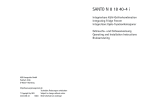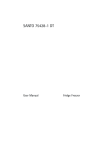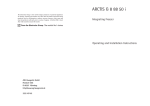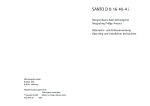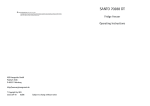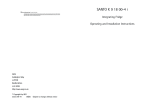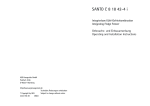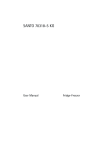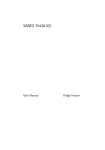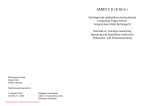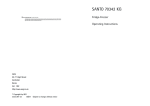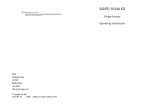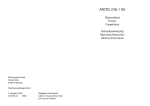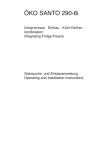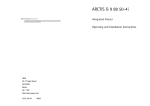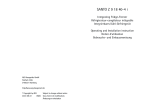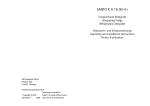Download AEG Integrating Freezer Operating instructions
Transcript
SANTO N 8 18 40-4 i Integrierbare Kühl-Gefrierkombination Integrating Fridge Freezer Integrerbare Kjøle-frysekombinasjoner Gebrauchs- und Einbauanweisung Operating and Installation Instructions Bruksanvisning AEG Hausgeräte GmbH Postfach 1036 D-90327 Nürnberg http://www.aeg.hausgeraete.de Technische Änderungen vorbehalten © Copyright by AEG Subject to change without notice 2223 208-32 06/05 Med forbehold om endringer Downloaded from Fridge-Manual.com Manuals Störung Mögliche Ursache Abhilfe An den undichten Stellen Türdichtung vorsichtig mit einem Haartrockner erwärmen (nicht Starke Reifbildung im Gerät, Türdichtung ist undicht (evtl. wärmer als ca. 50 °C). Gleichevtl. auch an der Türdichtung. zeitig die erwärmte Türdichnach Türanschlagwechsel). tung von Hand so in Form ziehen, daß sie wieder einwandfrei anliegt. Gerät steht nicht gerade. Ungewöhnliche Geräusche. Nach Änderung der Temperatureinstellung läuf der Kompressor nicht sofort an. Wasser am Kühlraumboden oder auf Abstellflächen. Verstellfüße nachjustieren. Gerät hat Kontakt mit der Wand oder mit anderen Gerät etwas wegrücken. Gegenständen. Ein Teil, z. B. ein Rohr, an der Geräterückseite berührt ein Gegebenenfalls dieses Teil anderes Geräteteil oder die vorsichtig wegbiegen. Wand. Dies ist normal, es liegt keine Der Kompressor läuft nach Störung vor. einiger Zeit selbsttätig an. Tauwasser-Ablaufloch ist ver- Siehe Abschnitt „Reinigung stopft. und Pflege“ Customer Service If you cannot find the remedy for a malfunction in these operating instructions, please contact your dealer or our customer service department. Addresses and telephone numbers are listed in the accompanying booklet "Guarantee Conditions/Customer Service Locations". Selective ordering of replacement parts can save unnecessary travel and costs. For this reason always provide the following appliance information: This information can be found on the serial plate in the interior at the left of the appliance. • Model Name • Model Number (PNC) • Serial Number (S-No.) We recommend that you enter this information here, so that it is handy if needed. Note: The customer bears the costs of unjustified customer service calls even during the guarantee period. Lampe auswechseln 1. 2. 3. 4. 5. 6. 7. Warnung! Stromschlaggefahr! Vor dem Lampenwechsel Gerät abschalten und den Netzstecker ziehen oder Sicherung abschalten bzw. herausdrehen. Lampendaten: 220-240 V, Fassung: E 14 Zum Abschalten des Gerätes Temperaturregler auf Stellung „0“ drehen. Netzstecker ziehen. Zum Auswechseln der Lampe drücken die hintere Arretierung gegen das Gehäuse bis die trasparente Abdeckung ausrastet.. Die Abdeckung in Pfeilrichtung abnehmen (siehe Abbildung). Ersetzen durch eine neue Birne gleicher Leistung (die maximale Leistung ist am Leuchtkörper angegeben). Lampenabdeckung wieder einsetzen. Gerät wieder in Betrieb nehmen. Downloaded from Fridge-Manual.com Manuals 24 Regulations, Standards, Guidelines This appliance was designed for household use and was manufactured in accordance with the appropriate standards. The necessary measures in accordance with appliance safety legislation regulations (GSG), accident prevention regulations for refrigeration appliances (VBG 20) and the regulations of the German Society of Electrical Engineers (VDE) were observed in the manufacture of this appliance. The refrigerant circuit has been checked for leaks. This appliance is in accordance with the following EU guidelines: – 73/23/EWG dated 19 February 1973 - low voltage guidelines. – 89/336/EWG dated 3 May 1989 (including guideline change notice 92/31/EWG) - EMV guideline 49 Malfunction Possible Cause Appliance is not level. Unusual noises. The appliance is touching the wall or other objects. A component, e.g. a pipe, on the rear of the appliance is touching another part of the appliance or the wall. The compressor does not start This is normal, no error has immediately after changing occurred. the temperature setting. Water on the floor or on stoWater drain hole is blocked. rage shelves. Remedy Readjust the feet. Move the appliance slightly. If necessary, carefully bend the component out of the way. The compressor starts after a period of time. See the "Cleaning and Care" section. Bestimmungen, Normen, Richtlinien Das Kältegerät ist für den Haushalt bestimmt und wurde unter Beachtung der für diese Geräte geltenden Normen hergestellt. Bei der Fertigung wurden insbesondere die nach dem Gerätesicherheitsgesetz (GSG), der Unfallverhütungsvorschrift für Kälteanlagen (VBG 20) und den Bestimmungen des Verbandes Deutscher Elektrotechniker (VDE) notwendigen Maßnahmen getroffen. Der Kältekreislauf wurde auf Dichtheit geprüft. Dieses Gerät entspricht den folgenden EG-Richtlinien: – 73/23/EWG vom 19.2.1973 - Niederspannungsrichtlinie – 89/336/EWG vom 3.5.1989 (einschließlich Änderungsrichtlinie 92/31/EWG) - EMV-Richtlinie Changing the light bulb 1. 2. 3. 4. 5. 6. Warning! There is a risk of electric shocks! Before changing the light bulb, switch off the appliance and unplug it, or pull the fuse or the circuit breaker. Light bulb data: 220-240 V To switch off the appliance, turn the temperature regulator to position "0". Unplug the mains plug. To change the light bulb press on the rear hook and at the same time slide the cover in the direction indicated by the arrow. Change the defective light bulb with one of the same power (the maximum power is shown on the light diffuser). Refit the light bulb cover. Put the refrigerator back into operation. Downloaded from Fridge-Manual.com Manuals 48 25 Dear customer, Before placing your new refrigerator/freezer into operation please read these operating instructions carefully. They contain important information for safe use, for installation and for care of the appliance. Please keep these operating instructions for future reference. Pass them on to possible new owners of the appliance. These operating instructions are for use with several technically comparable models with varying accessories. Please observe the notes which apply to your model. Notes which are important for your safety or for the proper functioning of the appliance are stressed with a warning triangle and/or with signal words (Warning!, Caution!, Attention!). Please observe the following carefully. Supplementary information regarding operation and practical applications of the appliance appear after this symbol. Tips and notes concerning economical and environmentally sound use of the appliance are marked with the flower. The operating instructions contain instructions for the correction of possible malfunctions by the user in the section "What to do if ...". If these instructions should not be sufficient, our customer service department is always available to you. Printed on paper manufactured with environmentally sound processes. who thinks ecologically acts accordingly ... Downloaded from Fridge-Manual.com Manuals 26 What to do if ... Correcting Malfunctions A malfunction may be caused by only a minor fault that you can rectify yourself using the following instructions. Do not perform any other work on the appliance if the following information does not provide assistance in your specific case. Warning! Repairs to refrigerators/freezers may only be performed by qualified service engineers. Improper repairs can give rise to significant hazards for the user. If your appliance needs repairing, please contact your specialist dealer or our Customer Service. Malfunction Possible Cause Remedy Appliance is not switched on Switch on the appliance. Mains plug is not plugged in Insert mains plug. or is loose. Appliance does not work. Check fuse, replace if necesFuse has blown or is defective. sary. Mains malfunctions are to be Socket is defective. corrected by an electrician. Turn the temperature regulaAppliance cools too much. Temperature is set too cold. tor to a warmer setting temporarily.. Temperature is not properly Please look in the "Initial Start adjusted. Up" section. Door was open for an exten- Open the door only as long as ded period. necessary. A large quantity of warm The food is too warm. Turn the temperature regulafood was placed in the tor to a colder setting tempoappliance within the last 24 rarily. hours. The appliance is near a heat Please look in the "Installation source. location" section. Interior lighting does not Please look in the "Changing Light bulb is defective. work. the Light Bulb" section. Carefully warm the leaking sections of the door seal with Door seal is not air tight (pos- a hair dryer (not hotter than Heavy build up of frost, possisibly after changing over the approx. 50 °C). At the same bly also on the door seal. time shape the warmed door hinges). seal by hand such that it sits correctly 47 2. 3. 4. 5. 6. 7. Defrost the freezer compartment prior to cleaning (see "Defrosting" section). Switch the appliance off and remove the plug from the mains, or switch off or turn out the circuit breaker or fuse. Clean the appliance and the interior accessories with a cloth and lukewarm water. Commercially available dish washing detergents may also be used. After cleaning wipe with fresh water and rub dry. Accumulation of dust at the condenser increases energy consumption. For this reason carefully clean the condenser at the back of the appliance once a year with a soft brush or a vacuum cleaner. Check the water drain hole on the rear wall of the fridge. Clear a blocked drain hole with the aid of the green peg in the pack of accessories included with the appliance. After everything is dry place appliance back into service. Energy Saving Tips • Do not install the appliance near cookers, radiators or other sources of warmth. High ambient temperatures cause longer, more frequent operation of the compressor. • Ensure sufficient air circulation and exhaust at the appliance base and at the back wall of the appliance. Never cover air vent openings. • Do not place warm foods into the appliance. Allow warm foods to cool first. • Only leave door open as long as necessary. • Do not set temperature any colder than necessary. • Put frozen food in the fridge to defrost. The cold in the frozen food will then be used to cool the fridge. • Keep the heat emitting condenser, the metall grille on the rear wall of your appliance, always clean. Downloaded from Fridge-Manual.com Manuals 46 Contents Safety . . . . . . . . . . . . . . . . . . . . . . . . . . . . . . . . . . . . . . . . . . . . . . . . .28 Disposal . . . . . . . . . . . . . . . . . . . . . . . . . . . . . . . . . . . . . . . . . . . . . . .30 Appliance Packaging Information . . . . . . . . . . . . . . . . . . . . . . . . . . . . . .30 Disposal of old Appliances . . . . . . . . . . . . . . . . . . . . . . . . . . . . . . . . . . . .30 Remove transport safeguard . . . . . . . . . . . . . . . . . . . . . . . . . . . . . . .30 Shelf holders . . . . . . . . . . . . . . . . . . . . . . . . . . . . . . . . . . . . . . . . . . . . . . .31 Installation . . . . . . . . . . . . . . . . . . . . . . . . . . . . . . . . . . . . . . . . . . . . .31 Installation Location . . . . . . . . . . . . . . . . . . . . . . . . . . . . . . . . . . . . . . . . .31 Your refrigerator needs air . . . . . . . . . . . . . . . . . . . . . . . . . . . . . . . . . . . .32 Rehingeing the door . . . . . . . . . . . . . . . . . . . . . . . . . . . . . . . . . . . . . . . . .32 Housing dimensions . . . . . . . . . . . . . . . . . . . . . . . . . . . . . . . . . . . . . . . . .33 Instructions for total built-in . . . . . . . . . . . . . . . . . . . . . . . . . . . . . . . . .33 Electrical Connection . . . . . . . . . . . . . . . . . . . . . . . . . . . . . . . . . . . . .37 Prior to Initial Start–Up . . . . . . . . . . . . . . . . . . . . . . . . . . . . . . . . . .37 Starting up and temperature regulation . . . . . . . . . . . . . . . . . . . . .37 Control panel . . . . . . . . . . . . . . . . . . . . . . . . . . . . . . . . . . . . . . . . . .38 Starting up and temperature regulation of freezer compartment 39 Quick-freezing . . . . . . . . . . . . . . . . . . . . . . . . . . . . . . . . . . . . . . . . . .39 Interior Accessories . . . . . . . . . . . . . . . . . . . . . . . . . . . . . . . . . . . . . .40 Storage shelves . . . . . . . . . . . . . . . . . . . . . . . . . . . . . . . . . . . . . . . . . . . . .40 Variable Inner Door . . . . . . . . . . . . . . . . . . . . . . . . . . . . . . . . . . . . . . . . . .40 Moisture regulator . . . . . . . . . . . . . . . . . . . . . . . . . . . . . . . . . . . . . . . . . .41 Variable Storage Box . . . . . . . . . . . . . . . . . . . . . . . . . . . . . . . . . . . . . . . . .41 Fresh food refrigeration . . . . . . . . . . . . . . . . . . . . . . . . . . . . . . . . . .42 Freezing and storing frozen food . . . . . . . . . . . . . . . . . . . . . . . . . . .42 Ice pack . . . . . . . . . . . . . . . . . . . . . . . . . . . . . . . . . . . . . . . . . . . . . . .43 Preparation of Ice Cubes . . . . . . . . . . . . . . . . . . . . . . . . . . . . . . . . . .44 Freezing calender . . . . . . . . . . . . . . . . . . . . . . . . . . . . . . . . . . . . . . . .44 Defrosting . . . . . . . . . . . . . . . . . . . . . . . . . . . . . . . . . . . . . . . . . . . . .44 Switching off the appliance . . . . . . . . . . . . . . . . . . . . . . . . . . . . . . .45 Cleaning and Care . . . . . . . . . . . . . . . . . . . . . . . . . . . . . . . . . . . . . . .45 Energy Saving Tips . . . . . . . . . . . . . . . . . . . . . . . . . . . . . . . . . . . . . . .46 What to do if . . . . . . . . . . . . . . . . . . . . . . . . . . . . . . . . . . . . . . . . . . .47 Correcting Malfunctions . . . . . . . . . . . . . . . . . . . . . . . . . . . . . . . . . . . . . .47 Changing the light bulb . . . . . . . . . . . . . . . . . . . . . . . . . . . . . . . . . . . . . .48 Customer Service . . . . . . . . . . . . . . . . . . . . . . . . . . . . . . . . . . . . . . . .49 Regulations, Standards, Guidelines . . . . . . . . . . . . . . . . . . . . . . . . .49 27 Safety The safety aspects of our refrigerators/freezers comply with accepted technical standards and the German Appliance Safety Law. Nevertheless, we consider it our obligation to make you aware of the following safety information: Intended use • The refrigerator is intended for use in the home. It is suitable for the cooling, freezing and storing of frozen food, as well as for making ice. If the appliance is used for purposes other than those intended or used incorrectly, no liability can be accepted by the manufacturer for any damage that may be caused. • Alterations or changes to the freezer are not permitted for reasons of safety. • If you use the refrigerator in a commercial application or forpurposes other than the cooling, freezing or frozen storage of foods,please observe all valid legal regulations for your application. Switching off the appliance 1. 2. 3. 4. 5. Cleaning and Care For hygienic reasons the appliance interior, including interior accessories, should be cleaned regularly. Prior to initial start–up Warning! • Check the refrigerator for transport damage. Under no circumstance should a damaged appliance be plugged in! In the event of damage, please contact the vendor. • The appliance may not be connected to the mains during cleaning. Danger of electrical shock! Before cleaning switch the appliance offand rem ve the plug from the mains, or switch off or turn out the circuit breaker or fuse. • Never clean the appliance with a steam cleaner. Moisture could accumulate in electrical components, danger of electrical shock! Hot vapours can lead to the damage of plastic parts. • The appliance must be dry before it is placed back into service. Attention! Refrigerant The refrigerant isobutane (R600a) is contained within the refrigerant circuit of the appliance, a natural gas with a high level of environmental compatibility, which is nevertheless flammable. • During transportation and installation of the appliance, be certain that none of the components of the refrigerant circuit become damaged. • If the refrigerant circuit should become damaged: – avoid open flames and sources of ignition; – thoroughly ventilate the room in which the appliance is situated. Safety of children • Packaging (e.g. wraps, polystyrene) can be dangerous for children. There is a risk of suffocation! Keep packaging material away from children! • Please make old appliances unusable prior to disposal. Pull out the mains plug, cut off the mains cable, break or remove spring or boltcatches, if fitted. By doing this you ensure that children cannot lock themselves in the Downloaded from Fridge-Manual.com Manuals 28 To switch off the appliance, turn the temperature regulator to position "0". If the appliance is not going to be used for an extended period: Remove all refrigerated and deep-frozen packages as well as ice trays. Switch off the appliance by turning the temperature regulator to position "0". Remove the mains plug or switch off or turn out the circuit breaker or fuse. Defrost freezer compartment and clean thoroughly (see section: “Cleaning and Care”). Leave the door open to avoid the build up of odours. 1. • Ethereal oils and organic solvents can attack plastic parts, e.g. – lemon juice or the juice from orange peals; – butyric acid; – cleansers which contain acetic acid. Do not allow such substances to come into contact with appliance parts. • Do not use any abrasive cleansers. Remove frozen food and the food from the refrigerator. Wrap frozen food in several layers of newspaper. Store it in a cool place, well covered. 45 Preparation of Ice Cubes 1. 2. Fill the ice cube tray 3/4 full with cold water, place it in the freezer compartment and leave to freeze. To loosen the frozen cubes, either bend the ice cube tray or hold it under running water for a few seconds. Important! Never try to free an ice tray that is frozen to the freezer compartment using pointed or sharp edged objects. Use the ice scraper supplied. Freezing Calendar • The symbols on the drawers show different types of frozen goods. • The numbers indicate storage times in months for the appropriate types of frozen goods. Whether the upper or lower value of the indicated storage time is valid depends on the quality of the foods and pre-treating before freezing. The lower value applies to foods with high fat content. Defrosting Refrigerator Frost is automatically eliminated from the evaporator of the refrigerator compartment every time the motor compressor stops, during normal use. The defrost water drains out through a trough into a special container at the back of the appliance, over the motor compressor, where it evaporates. We particulary recommend that you peridically clean the defrost-water drainage outlet, located in the center of the drainage groove in the refrigerator compartment, to prevent the defrost water form overflowing on to foods stored in the compartment. Use a special cleaner provided, which you will find already inserted into the discharge hole. fridge when playing (there is risk of suffocation!)or get themselves into other dangerous situations. • Often children cannot recognise the hazards present in household appliances. It is therefore important that you ensure adequate supervision and never let children play with the appliance! Daily Operation • Containers with flammable gases or liquids can leak at low temperatures. There is a risk of an explosion! Do not store any containers with flammable materials such as, for example, spray cans, fire extinguisher refill cartridges etc in the refrigerator/freezer. • Bottles and cans must not be placed in the freezer compartment. They can burst when the contents freeze, high carbonate content drinks can even explode! Never store lemonade, juices, beer, wine, sparkling wine etc. in the freezer compartment. Exception: high alcohol content spirits can be stored in the freezer compartment. • Do not put ice creams or ice cubes in the mouth immediately after removal from the freezer compartment. Very cold ice can freeze to the lips or tongue and cause injury. • Do not touch frozen food with wet hands. Your hands could freeze to the food. • Do not operate any electrical appliances in the refrigerator/freezer (e.g. electric ice cream makers, mixers etc.). • Before cleaning the appliance, always switch off the appliance and unplug it, or pull the house fuse or switch off the circuit breaker. • When unplugging always pull the plug from the mains socket, do not pull on the cable. In case of malfunction • If the a malfunction occurs on the appliance, please look first in the "What to do if ..." section of these instructions. If the information given there does not help, please do not perform any further repairs yourself. • Refrigerators/freezers may only be repaired by qualified service engineers. Improper repairs can give rise to significant hazards. If your appliance needs repairing, please contact your specialist dealer or our Customer Service. Freezer The inner walls of the freezer are automatically defrosted Downloaded from Fridge-Manual.com Manuals 44 29 Disposal Appliance Packaging Information All materials are environmentally sound! They can be dumped or burned at an incinerating plant without danger! About the materials: The plastics can be recycled and are identified as follows: >PE< for polyethylene, e.g. the outer covering and the bags in the interior. >PS< for polystyrene foam, e.g. the pads, which are all free of chlorofluorocarbon. The carton parts are made from recycled paper and should be disposed of at a waste-paper recycling collection location. Disposal of old Appliances For environmental reasons, refrigeration appliances must be disposed of properly. This applies to your old appliance, and - at the end of its service life - for your new appliance as well. Warning! Before disposing of old appliances make them inoperable. Remove plug from mains, sever the power cable, remove or destroy any snap or latch closures. This eliminates the danger that playing children lock themselves into the appliance (danger of suffocation!) or place themselves into other life-endangering situations. Disposal: • The appliance may not be disposed of with domestic waste or bulky refuse. • The refrigerant circuit, especially the heat exchanger at the back of the appliance, may not be damaged. • The symbol on the product or on its packaging indicates that this product may not be treated as household waste. Instead it shall be handed over to the applicable collection point for the recycling of electrical and electronic equipment. By ensuring this product is disposed of correctly, you will help prevent potential negative consequences for the environment and human health, which could otherwise be caused by inappropriate waste handling of this product. For more detailed information about recycling of this product, please contact your local city office, your household waste disposal service or the shop where you purchased the product. Remove transport safeguard The appliance and the interior fittings are protected for transport. • Pull off the adhesive tape on the left and right side of the door. • Remove all adhesive tape and packing pieces from the interior of the Downloaded appliance. from Fridge-Manual.com Manuals 30 1. 2. 3. • Please note the maximum storage times specified by the manufacturer. • Thawed foods which have not been processed further (cooked into meals) may not under any circumstances be frozen a second time. • Containers with flammable gases or liquids can leak at low temperatures. There is a risk of an explosion! Do not store any containers with flammable materials such as, for example, spray cans, fire extinguisher refill cartridges etc in the refrigerator/freezer. • Bottles and cans must not be placed in the freezer. They can burst when the contents freeze, high carbonate content drinks can even explode! Never store lemonade, juices, beer, wine, sparkling wine etc. in the freezer. Exception: high alcohol content spirits can be stored in the freezer. • All foods must be packed air tight prior to freezing, so that they do not dry out or lose their flavour, and so that no flavour contamination of other frozen goods occurs. Caution! Do not touch frozen food with wet hands. Your hands could freeze to the food. To garantee a good operation of the appliance during normally use, please do not take out the drawers. Place the packed food in the drawers. Place food to be frozen in the middle drawer equipped with its own refrigerating unit. Unfrozen food must not touch items already frozen, otherwise the frozen food could begin to defrost. When frezzing fresh food, depress theambient temperature switch (A) 24 hours before loading the food without modifying the thermostat setting. The pilot light will come on. At the end of the freezing process, do not forget to depress again the ambient switch in order to avoid an increase of the power consumption. Place frozen foods in the drawers sorted by type, as far as possible. Ice pack There could be one or more ice packs in one drawer of the freezer. In the event of a power failure or malfunction, the ice pack will lengthen the amount of time it takes for the frozen food to become too warm by several hours. The ice pack can only fulfil this task optimally if it is placed in the uppermost drawer, at the front, above the frozen food. You can use the ice pack for cooling cold bags. 43 Fresh food refrigeration To obtain the best performance: • do not store warm food or evaporating liquide in the refrigeator • do cover or wrap the food, particularly if it has a strong flavour. • Position food so that air can circuiate freely round it. Useful hints: Meat (all types): wrap in polythene bags and place on the glass shelf above the vegetable drawer(s)For safety, store in this way only one or two days at the most. Cooked foods, cold dishes, etc: these should be covered and may be placed on any shelf. Fruit and vegetables: these should be thoroughly cleaned and placed in the special drawer(s) provided. Butter and cheese: these should be placed in special airtight containers or wapped in aluminium foil or polythene bags to exclude as much air as possible. Milk bootles: these should have a cap and should be stored in the bottle rack on the door. Bananas, potatoes, onions and garlic, if not packed, must not be kept in the refrigerator. Freezing and storing frozen food You can use your freezer for freezing fresh food yourself. Important! • The temperature in the freezer compartment must be –18 °C or colder before freezing food. • Please observe the freezing capacity given on the rating plate. The freezing capacity is the maximum quantity of fresh food that can be frozen within a period of 24 hours. If you wish to freeze food several days in a row, please observe a maximum capacity of only 2/3 to 3/4 of that on the rating plate. The quality of the food is best preserved when it is frozen right through to the core as quickly as possible. • Allow warm food to cool down before freezing. The warmth will cause increased ice formation and increase the power consumption. Downloaded from Fridge-Manual.com Manuals 42 Shelf holders Your appliance is equipped with shelf retainers that make it possible to secure the shelves during transportation. To remove them proceed as follows: Raise the shelf from the back, push it in the direction of the arrow until it is freed and remove the retainers. A B Installation Installation Location The appliance should be set up in a well ventilated, dry room. Energy use is affected by the ambient temperature. The appliance should therefore – not be exposed to direct sunlight; – not be installed next to radiators, cookers or other sources of heat; – only be installed at a location whose ambient temperature corresponds to the climate classification, for which the appliance is designed. The climate classification can be found on the serial plate, which is located at the left on the inside of the appliance. The following table shows which ambient temperature is correct for each climate classification: each climate classification: Climate classification for an ambient temperature of SN +10 bis +32 °C N +16 bis +32 °C ST +18 bis +38 °C T +18 bis +43 °C If installation next to a source of heat is unavoidable, the following minimum clearances must be maintained at the sides of the appliance: – for electric cookers 3 cm; – for oil and coal fired ranges 30 cm. If these clearances cannot be maintained a heat insulating pad is required between the cooker and the refrigeration appliance. If the refrigeration appliance is installed next to another refrigerator or freezer a clearance of 5 cm at the sides is required, in order to prevent the formation of condensation on the outside of the appliance. 31 Your appliance needs air 50 mm For safety reasons, minimum ventilationmust be as shown Fig. Attention: keep ventilation openings clear of obstruction; Moisture regulator min. 200 cm 2 There is an adjustable air grille in front of the shelf above the fruit and vegetable compartments. The opening in the ventilation slots can be adjusted with the slider. Right slider: Ventilation slots opened. With the ventilation slots open, more air circulation results in a lower air moisture content in the fruit and vegetable compartments. Left slider: Ventilation slots closed. When the ventilation slots are closed, the natural moisture content of the food in the fruit and vegetable compartments is preserved for longer. min. 200 cm2 D567 Rehingeing the door 1. 2. 3. 4. The side at which the door opens can be changed from the right side (factory adjustment) to the left side, if the installation site requires. Warning! When changing the side at which the door opens, the appliance may not be connected to the mains. Remove plug from the mains beforehand. Unscrew the upper pin and remove the spacer Remove the upper door Remove the hinge cover (A). Unscrew the pins (B) and the spacers (C) and refit them on the middle hinge of the opposite side. Snap the hinge cover (A). Refit the upper door, the upper pin and the spacer on the oppo- Variable Storage Box 1. 2. Some models are equipped with a variable storage box which is fitted under a door shelf compartment and can be slid sideways. The box can be inserted under any door shelf compartment. To change the position of the storage box; lift the shelf compartment with the box upwards and out of the holders in the door and remove the retaining bracket out of the guide under the shelf compartment. Reverse the above operation to insert the shelf at a different height. C B Downloaded from Fridge-Manual.com Manuals 32 A 41 Interior Accessories Storage Shelves The glass shelf above the fruit and vegetable compartment should always remain in position, to ensure fruit and vegetables stay fresh longer. The remaining storage shelves can be adjusted to various heights: Pull the storage shelf forward until it can be tipped up or down and remoD338 ved. To insert at a different height use the same procedure in reverse. Adjustment for tall goods: Remove the front half of the two-part vario glass storage shelf and insert it at a different level. Space is thus gained for storage of tall goods on the underlying storage shelf. 5. site side Unscrew the lower pin and remove the spacer and refit them on the opposite side Housing dimensions Height Depth Width 1780 mm 550 mm 560 mm Instructions for total built-in Apply joint the sealing strip as shown in figure. Variable Inner Door The door compartments can be pulled up and removed, and inserted at other positions as needed. D765 Fit the appliance in the niche by making sure that it stands against the interior surface of the unit on the side where the door hinges of the appliances are fitted. Insert the appliance until the upper strip butts up against the unit (1) and make sure that the lower hinge is in line with the surface of the unit (2). 1 2 D023 Downloaded from Fridge-Manual.com Manuals 40 33 Starting up and temperature regulation of freezer compartment Fasten the appliance with 4 screws provided in the kit included with the appliance. (I = short) (P = long) • Turn the temperature regulator (B) in the direction of “1”. The green(A) comes on. The freezer motor starts up. • Psuh the Normal/Super push button (D), the yellow light (B) comes on; Setting “0”: Off. Setting “1”: Hightest temperature, (warmest setting). Setting “4” (end-stop) : Lowest temperature, (coldest setting). The exact setting should be chosen keeping in mind that the temperature inside the appliance depends on: - the quantity of food stored - how often the door is opened - ambient temperature I P Apply covers (C-D) on joint cover lugs and into hinge holes. Snap vent grille (B) and hinge cover (E) into position. D C Quick-freezing E B Separate parts Ha, Hb, Hc, Hd as shown in the figure Hb Ha For quick-freezing, push the Normal/Super button (D). The super control light (C) will then light up. The Quick-freezing function accelerates the freezing of fresh food and, at the same time, protects foodstuffs already stored from undesirable warming. If this function is not ended manually, the appliance switches off the Quick-freezing function after 52 hours. The yellow light goes out. This function can be ended manually at any time by pressing the Normal/Super button again. The yellow light goes out. Hc Hd PR266 Downloaded from Fridge-Manual.com Manuals 34 39 However, the exact setting should be chosen keeping in the mind that the temperature inside the refrigerator depends on: -the quantity of food stored -how often the door is opened The temperatures in the refrigerator compartment and freezer co partment cannot be independently regulated. If you want the freeze fresh food rapidly, select setting „6“, ensuring that the temperature in the refrigerator compartment does not drop blow 0°C. You should also promptly reset the temperature regulator to setting „3“ or „4“. Important! High ambient temperatures (e.g. on hot summer days) and a cold setting on the temperature regulator (position"5" to "6") can cause the compressor to run continuously. If this happens, turn the temperature regulator back to a warmer setting (position "3" to "4"). At this setting the compressor will be switched on and off as usual and automatic defrosting recommenced. Place guide (Ha) on the inside part of the furniture door, up and down as shown in the figure and mark the position of external holes. After having drilled holes, fix the guide with the screws supplied. ca. 50 mm 90° 21 m m 90° ca. 50 mm Fix cover (Hc) on guide (Ha) until it clips into place. 21 m m Ha Control panel 1 2 6 5 A 4 Hc 3 B C PR33 D A. Pilot light (green) B. Thermostat knob C. Super control light (yellow) D. Normal/Super push button The control panel elements are: the thermostat (B) is also the on/off switch . The green pilot light (A), which comes on when the mains voltage is availble. Switch the temperature regulator knob to a number position, the refrigerating unit automatically operates by system control. The yelloew pilot light (C) comes on when the normal/super push botton is pushed. Important note: if you operate the fast-freeze switch or adjust the temperature regulator, it may happen that your appliance’s refrigeration motor does not start immediately but only after some time. This does not mean that your appliance has a fault.. Downloaded from Fridge-Manual.com Manuals 38 Open the appliance door and the furniture door at 90°. Insert the small square (Hb) into guide (Ha). Put together the appliance door and the furniture door and mark the holes as indicated in the figure. 8mm Ha PR167 Hb 35 Remove the brackets and mark a distance of 8 mm from the outer edge of the door where the nail must be fitted (K). If the appliance is fixed to the side of the kitchen unit, simply slacken the screws in the fixing brackets (E), move the brackets as shown in the figure and re-tighten the screws. 8mm K Ha Electrical connection Place the small square on the guide again and fix it with the screws supplied. Should the lining up of the furniture door be necessary, use the clearance of slots. At the end of operations, it is necessary to check if the door of the furniture closes properly. Hb PR168 Before initial start-up, refer to the appliance rating plate to ascertain if supply voltage and current values correspond with those of the mains at the installation location. e.g.: AC 220 ... 240 V 50 Hz or 220 ... 240 V~ 50 Hz (i.e. 220 to 240 volts alternating current, 50 Hertz) The rating plate is inside the appliance on the left. A correctly installed, earthed socket is required for the electrical supply. The supply must have a fuse rating of at least 10 Amps. If the socket is not accessible once the appliance is built in, the electrical installation must include suitable means of isolating the appliance from the mains (e.g. fuse, cut-out, current trip or similar with a minimum contact separation of 3 mm). Attention: The mains connection cable may only be replaced by a skilled electrician. Please contact your dealer or our customer service department for repairs. • Please clean the appliance interior and all accessories prior to initial startup (see section: “Cleaning and Care”). Starting up and temperature regulation Hb Hd PR167/1 36 E Prior to Initial Start–Up Fix cover (Hd) on guide (Hb) until it clips into place. Downloaded from Fridge-Manual.com Manuals E D735 0 Insert the plug of the connection lead into the plug socket with protective earth contact. When the refrigerator compartment door is opened, the internal lighting is switched on. The temperature selector knob is located on the control panel. Setting „0“ means: Off. Setting „1“ means: Hightest temperature, (warmest setting). Setting „6“ (end-stop) means: Lowest temperature, (coldest setting). 37














